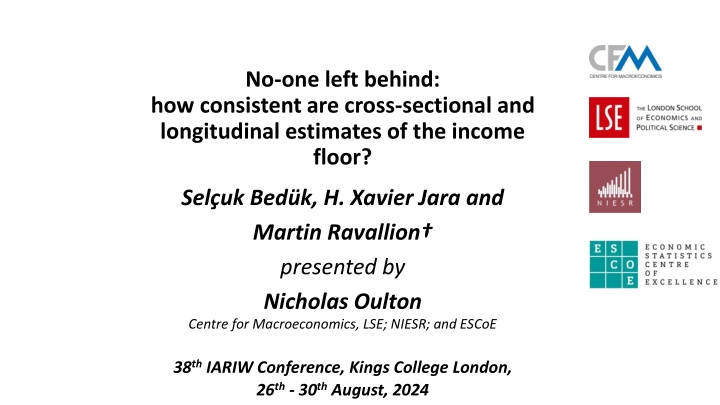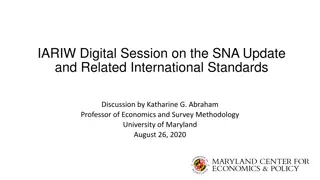
Income Floor Estimates for UK Households 1991-2021: Cross-sectional vs Longitudinal Methods
Explore income floor estimates for UK households from 1991 to 2021 using cross-sectional and longitudinal methods. Analyze changes in living standards over time and compare data sources from the British Household Panel Survey. Learn about the concept of the income floor and its implications for measuring poverty and economic growth.
Download Presentation

Please find below an Image/Link to download the presentation.
The content on the website is provided AS IS for your information and personal use only. It may not be sold, licensed, or shared on other websites without obtaining consent from the author. If you encounter any issues during the download, it is possible that the publisher has removed the file from their server.
You are allowed to download the files provided on this website for personal or commercial use, subject to the condition that they are used lawfully. All files are the property of their respective owners.
The content on the website is provided AS IS for your information and personal use only. It may not be sold, licensed, or shared on other websites without obtaining consent from the author.
E N D
Presentation Transcript
No-one left behind: how consistent are cross-sectional and longitudinal estimates of the income floor? Sel uk Bed k, H. Xavier Jara and Martin Ravallion presented by Nicholas Oulton Centre for Macroeconomics, LSE; NIESR; and ESCoE 38thIARIW Conference, Kings College London, 26th- 30thAugust, 2024
Summary This paper calculates the income (or consumption) floor for UK households over the period 1991-2021. It compares and contrasts two different methods: cross-sectional and longitudinal. It analyses the causes of changes in the floor over this period. All data are drawn from the British Household Panel Survey (BHPS), 1991-2008, and its successor, the UK Household Longitudinal Survey (UKHLS), 2009- .
This paper draws on: Martin Ravallion, Are the world s poorest being left behind? , Journal of Economic Growth, 2016.
Ravallion Ravallion (2016) (2016) He argued that conclusions drawn in the 2000s that economic growth was making the poor better off in developing countries were potentially misleading. It was possible that the poorest at least were being left behind. He introduced the concept of the consumption floor : essentially, the living standard of the poorest household. This can be justified on Rawlsian grounds: the social welfare function should maximise the living standard of the poorest household. So the empirical question was: is the consumption floor rising over time? A constant or falling floor is consistent with rising mean or even median consumption. He contrasted his approach with what he called the counting approach to measuring poverty. Latter means counting the proportion of the population who fall below some poverty level , e.g. $2.15 a day (an absolute standard, though a relative standard is also possible). Poverty could be declining on the counting approach but nevertheless the poorest might not be getting any better off. Using household surveys, he found that in developing countries, over the 30 years up to around 2010, the consumption floor had not risen. So even though the poor had on average benefited from economic growth, there was a substantial number who had not.
This paper The authors apply these ideas to the UK. They estimate the consumption floor over 1991-2021 by two methods: i. Cross-sectional (as in Ravallion (2016)) ii. Longitudinal (new) They actually call the consumption floor the income floor because they look at income measures but conceptually their income floor is meant to be a measure of living standards. Their income measure: equivalised household disposable income, i.e. income from all sources including benefits but after subtracting taxes on income, corrected for household size and number of children. It does not include free health and educational services.
Permanent versus actual income Ravallion (2016) recognised that actual income in the survey period might not be a good estimate of a household s typical standard of living, due to transitory factors. He estimated permanent income from actual income. He assumed that, below a given poverty level, the probability of actual income being at its floor rose as income fell. The floor in any period is then the minimum of estimated permanent income. This is the cross- sectional method. This procedure requires assuming two parameter values: (1) the poverty level (above which actual income has zero probability of being the floor); and (2) a curvature parameter.
The longitudinal method For the UK, a longitudinal panel survey is available: the British Household Panel Survey, superseded in 2009 by the UK Household Longitudinal Survey. For the longitudinal method, the authors estimate the floor as the minimum of a moving average of annual incomes of the households. They calculate 3-, 5- or 7-year moving averages but prefer 5-year ones.
Figure 1. Estimates of the income floor in the UK, 1991-2021 (cross-sectional compared to longitudinal)
Findings The cross-sectional and longitudinal estimates are quite similar. The income (consumption) floor increased substantially from 1991 up till 2008, fell sharply in 2009, then increased substantially again before peaking in 2014. From 2015 onwards the floor has been mostly falling. In 2021 it was about the same level as in 2000. The floor is almost entirely determined by benefits (social protection). So the authors attribute the decline in the floor to austerity (the policies of the Conservative-Lib. Dem coalition in power 2010 to 2015, then Conservatives alone 2015 onwards).
Comments Small point. The vertical scale in Figure 1 seems wrong even though it is in 2010 . It says that the highest level of income per equivalent household member was about 14 per day or 5,000 per year. Bigger point. Since 2007 and following the Global Financial Crisis and the Great Recession, living standards have stagnated in the UK: they are no higher today than they were in 2007. So what is remarkable about Figure 1 is not the fall in the floor from 2015 onwards but rather the rise from 2007. In general, living standards at all levels of income have been correlated with productivity in the UK. But productivity has stagnated since 2007 (Oulton, International Productivity Monitor, 2022).
Comments, cont. The consumption floor is an interesting and useful statistic. But the proportion of the population at (or near) the floor is also significant (in my view). The paper would be improved if the authors gave these numbers and discussed how they have changed over time.
Thanks for listening and for the opportunity to present this paper!






















